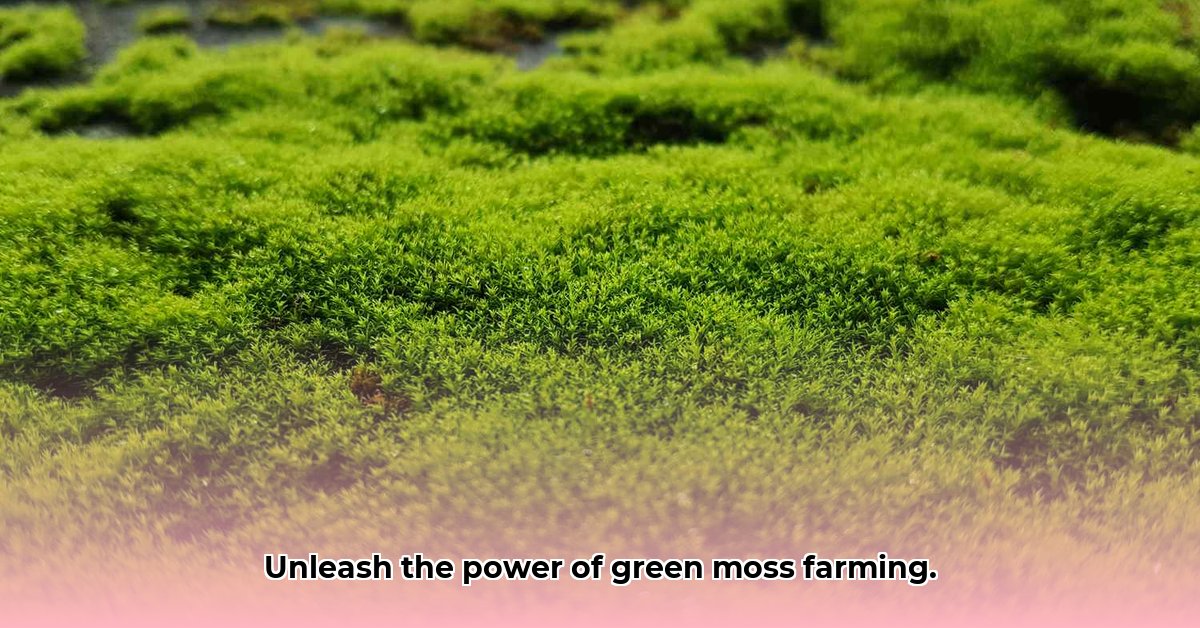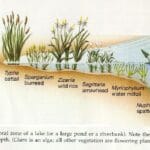Facing challenges with soil erosion, water conservation, and environmentally friendly farming? You might be surprised to learn that moss could be the solution you’ve been searching for! This review dives deep into how moss can help create a more sustainable and productive farm. We’ll explore which types of moss work best, how to successfully integrate them into your existing practices, and proven techniques for making the most of this natural resource. We’ll even tackle the important issue of weed control to ensure your moss-based system thrives. Get ready to discover how this often-overlooked plant can revolutionize your farming methods and help build a healthier, more resilient farm for the future.
Green Moss: A Sustainable Farming Revolution?
Green moss – that often-missed, unassuming ground cover – might just be the unsung hero of sustainable farming. It’s low-maintenance, needing little to no fertilizing and no mowing. Plus, it thrives in those tricky, compacted, acidic soils that often give conventional crops a hard time. But is it a miracle cure-all for our farming challenges? Let’s delve in.
Many studies show green moss is a champion at preventing soil erosion and managing stormwater. Its thick, lush growth acts like a natural barrier, stopping topsoil from washing away. Since healthy topsoil is a farmer’s most valuable resource, this is a big deal. And it’s not just about soil; moss is also a water-wise wonder. Its amazing ability to hold onto moisture dramatically reduces the need for irrigation – a significant advantage, especially during droughts. Furthermore, moss doesn’t require fertilizers, reducing the risk of groundwater contamination.
Evaluating Soil Health Improvement with Green Moss
We’ve got exciting possibilities here, but we also need to be realistic. Let’s look at both sides of the coin:
| Advantage | Disadvantage |
|---|---|
| Requires minimal upkeep | Establishing a moss cover takes time (12-18 months or more) |
| Tolerates dry conditions | Needs diligent weed control, especially initially |
| Improves soil health | Long-term effects on crop yields need more study |
| Prevents erosion and runoff | Best planting methods aren’t universally agreed upon |
| Adaptable to acidic soils | Soil pH needs to be just right (around 5.0-6.0) |
| May naturally suppress weeds | You’ll need to carefully choose the right moss species for your specific needs. |
| Provides habitat for beneficial insects | Can harbor unwanted pests if not properly managed |
Implementing a Green Moss System: A Step-by-Step Plan
Intrigued by the prospect of incorporating green moss into your farm? It’s certainly achievable, but careful planning is key. Consider this step-by-step approach:
- Choosing the Right Moss: Start by selecting moss varieties that will flourish in your unique climate and soil type. Consider factors like sun exposure, water tolerance, and growth direction. Sheet moss (Hypnum spp.) is easy to transplant. Cushion moss (Leucobryum glaucum) grows in clumps. Rock cap moss (Dicranum spp.) suits deep shade, while hair cap moss (Polytrichum commune) tolerates sun with enough water.
- Preparing the Ground: Before you even think about planting, check your soil’s pH. Aim for around 5.0 to 6.0; make adjustments if needed using elemental sulfur or an organic soil acidifier. Thorough weed control is also crucial at this stage to give your moss the best possible start. Compact the soil by walking over it or using a tamper.
- Planting Your Moss: There are several methods to choose from: you might work with pre-grown moss sheets, individual moss plugs, or even transplant existing moss. Moisten the soil, then lay down moss sheets or spread clumps. Press the moss into the soil, securing with landscape staples if needed.
- Ongoing Care: After planting, regularly remove any fallen leaves or debris that could smother your moss. Weed control remains important, particularly in the initial phases of establishment. Established moss needs watering only during droughts.
- Monitoring and Observing: Keep a close eye on your green moss patch. Track soil moisture levels, watch for weed growth, and assess the overall health of your moss. This allows you to make informed adjustments along the way.
Economic Data and Future Research Needed for Green Moss Integration
Although the advantages of green moss are becoming clearer, we still have a lot to learn. For example, we lack detailed, long-term economic data on integrating moss into farming systems. Future research should focus on several key areas:
- Quantifying the Impact: We need more precise measurements of how effectively green moss reduces erosion and conserves water.
- Understanding Species-Specific Benefits: Research how different moss species impact soil composition and nutrient cycling.
- Optimizing Planting: Developing best practices for planting moss across different climates and soil conditions, including ideal planting densities and soil preparation techniques.
- Long-Term Sustainability: Assessing the long-term benefits and economic viability of integrating green moss into agricultural practices. Is it truly financially sustainable in the long run?
- Pest and Disease Resistance: Investigate the susceptibility of different moss species to pests and diseases, and develop strategies for prevention and control.
Sustainable agriculture: Future of green moss
Green moss shows so much promise as a sustainable farming tool! Its natural resilience and environmental benefits are undeniable. However, challenges remain; it takes time for the moss to establish itself and we still need more scientific data to really understand the full potential. With continued research and careful planning, green moss could completely transform how we farm, leading to a greener, more sustainable agricultural sector. This represents a future well worth investing in.
How to Effectively Control Weeds When Using Moss in Sustainable Agriculture
Key Takeaways:
- Sustainable moss gardening hinges on a balanced approach: prevention and reaction.
- Soil preparation is crucial; correct pH and nutrient levels are key.
- Manual weeding remains an effective, eco-friendly option.
- Mulching helps retain moisture and suppress weeds.
- Careful consideration of chemical vs. natural weed control is vital. Chemical options should only be used as a last resort and in strict accordance with regulations.
- Long-term success depends on continuous monitoring and adaptation.
Understanding Moss-Weed Competition in Sustainable Environments
Moss and weeds compete for resources. Want a thriving moss garden? You need to outsmart the weeds! Think of it like a gardening chess match – you need a strategy. This means understanding what makes moss flourish and what weeds thrive on. Acidic, nutrient-poor soil generally favors moss over many weeds. This is your first weapon in the arsenal.
Prevention is Key: Sustainable Moss Gardening Methods
Before you even plant your moss, prepare the ground meticulously. This is where you lay the groundwork for a weed-free future.
- Soil Testing: Analyze your soil’s pH and nutrient levels. Moss prefers slightly acidic conditions (pH 5.0 to 6.0). Amendments like elemental sulfur or pine needles can help adjust pH.
- Site Selection: Choose a shady area with good air circulation. Many weeds favor sun.
- Species Selection: Some moss species are more resilient to weed competition than others. Pleurocarpous mosses spread horizontally and can handle some foot traffic, while Acrocarpous mosses grow upright but are more vulnerable. Research your options.
Natural vs Chemical: Weed Managing in Moss Gardens
Even with careful planning, weeds will inevitably appear. Here’s how to effectively control weeds when using moss in sustainable agriculture:
- Manual Weeding: This is your primary tool. Regular, diligent hand-weeding is highly effective. Use tools appropriate for your garden size.
- Mulching: A thin layer of mulch (shredded bark, leaf litter, or pine needles) suppresses weed growth and conserves moisture. Choose a mulch compatible with your moss.
- Natural Herbicides: Vinegar or boiling water can target unwanted plants without harming the moss, but use these methods cautiously and selectively.
- Chemical Herbicides (Last Resort): Only consider these if other methods fail. Strictly follow label instructions and regulations. This is a significant risk to soil health and biodiversity. Spot treat weeds rather than applying herbicides broadly.
Continuous Monitoring: Sustainable Moss Garden Health
Successful moss gardening is not a one-off event. It’s an ongoing process. Regular monitoring is key. Observe your moss garden’s health and adjust your management strategies as needed. This includes adapting to changes in weather patterns and weed pressure.
This approach mirrors sustainable agricultural methods––working with nature, rather than against it.
Species-Specific Weed Control: Moss Research
Research into species-specific weed control is important. Some mosses tolerate specific weed pressures better than others. Different regions also face different weed challenges. Adapt your methods to these local conditions.
Moss-Based Weed Control Strategies for Sustainable Agriculture
Key Takeaways:
- Sustainable weed management needs a mix of traditional and new methods.
- We need to move from reacting to problems to preventing them.
- Moss’s role in sustainable agriculture needs more research.
- Different weed control methods work better in different places.
- Long-term effects on soil health are very important.
Sustainable farming? Potential role of moss.
Can moss be a key player in sustainable farming? It’s a question worth exploring
- Decoding ancient roman armour: Legionary evolution, plus battlefield impact. - August 17, 2025
- Decoding Ancient Warfare: Ancient Roman Soldier Armor Tactics Revealed - August 16, 2025
- Unveiling ancient rome generals’ tactics for empire’s rise: Triumphs decoded. - August 16, 2025
















